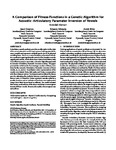A Comparison of Fitness Functions in a Genetic Algorithm for Acoustic–Articulatory Parameter Inversion of Vowels
| dc.contributor.author | Drayton, J | |
| dc.contributor.author | Miranda, Eduardo | |
| dc.contributor.author | Kirke, Alexis | |
| dc.date.accessioned | 2018-03-05T13:56:20Z | |
| dc.date.available | 2018-03-05T13:56:20Z | |
| dc.date.issued | 2017-07-15 | |
| dc.identifier.uri | http://hdl.handle.net/10026.1/10941 | |
| dc.description.abstract |
Articulatory speech synthesis provides an alternative to the state of the art concatenative and formant systems, holding potential for more versatile and expressive artificial speech due to its physical modelling basis. However, a major limitation of practical articulatory synthesis is gaining adequate control of the complex underlying physical models, which stems from a lack of articulatory data. In an effort to procure more data, a Genetic Algorithm approach to Acoustic-Articulatory Parameter Inversion is taken. This paper presents the initial results from testing a number of fitness functions for the Acoustic-Articulatory Parameter Inversion of three vowels, /a/, /o/, and /e/. Three feature vector representations of the vowels were tested; Hertz, Mel-scale, and Cents, in conjunction with three distance metrics. The distance metrics defined the fitness score by calculating the similarity between a candidate and targets feature vector. A Voiced/Un-Voiced constraint was also added as a penalty function, and an indicator of loudness was implemented using a Root Mean Square based co-efficient. The results indicated that certain combinations of the above could lead to convergence towards all three vowels. However, the quality of convergence was not uniform. | |
| dc.format.extent | 271-272 | |
| dc.language.iso | en | |
| dc.publisher | ACM | |
| dc.subject | Genetic Algorithm | |
| dc.subject | Speech Synthesis | |
| dc.subject | Physical Modelling | |
| dc.title | A Comparison of Fitness Functions in a Genetic Algorithm for Acoustic–Articulatory Parameter Inversion of Vowels | |
| dc.type | conference | |
| plymouth.author-url | https://www.webofscience.com/api/gateway?GWVersion=2&SrcApp=PARTNER_APP&SrcAuth=LinksAMR&KeyUT=WOS:000625865500136&DestLinkType=FullRecord&DestApp=ALL_WOS&UsrCustomerID=11bb513d99f797142bcfeffcc58ea008 | |
| plymouth.date-start | 2017-07-15 | |
| plymouth.date-finish | 2017-07-19 | |
| plymouth.conference-name | Genetic and Evolutionary Computation Conference 2017 | |
| plymouth.publication-status | Published | |
| plymouth.journal | Proceedings of Genetic and Evolutionary Computation Conference | |
| dc.identifier.doi | 10.1145/3067695.3076112 | |
| plymouth.organisational-group | /Plymouth | |
| plymouth.organisational-group | /Plymouth/Faculty of Arts, Humanities and Business | |
| plymouth.organisational-group | /Plymouth/Faculty of Arts, Humanities and Business/School of Society and Culture | |
| plymouth.organisational-group | /Plymouth/REF 2021 Researchers by UoA | |
| plymouth.organisational-group | /Plymouth/REF 2021 Researchers by UoA/UoA33 Music, Drama, Dance, Performing Arts, Film and Screen Studies | |
| plymouth.organisational-group | /Plymouth/Users by role | |
| plymouth.organisational-group | /Plymouth/Users by role/Academics | |
| dc.publisher.place | Berlin, Germany | |
| dcterms.dateAccepted | 2017-06-30 | |
| dc.rights.embargoperiod | Not known | |
| rioxxterms.version | Accepted Manuscript | |
| rioxxterms.versionofrecord | 10.1145/3067695.3076112 | |
| rioxxterms.licenseref.uri | http://www.rioxx.net/licenses/all-rights-reserved | |
| rioxxterms.licenseref.startdate | 2017-07-15 | |
| rioxxterms.type | Conference Paper/Proceeding/Abstract |


